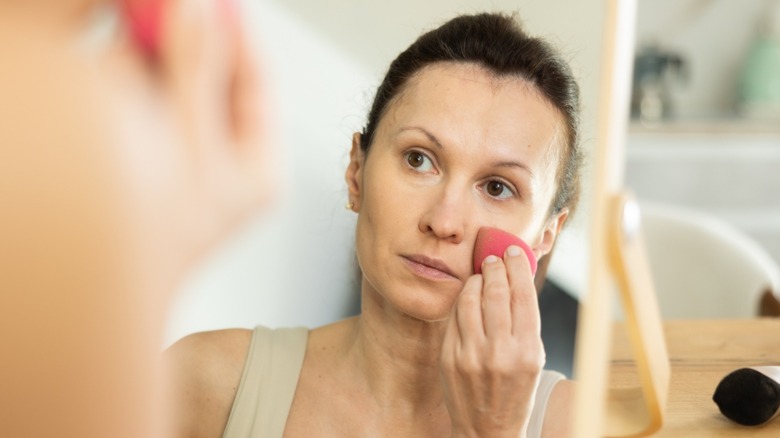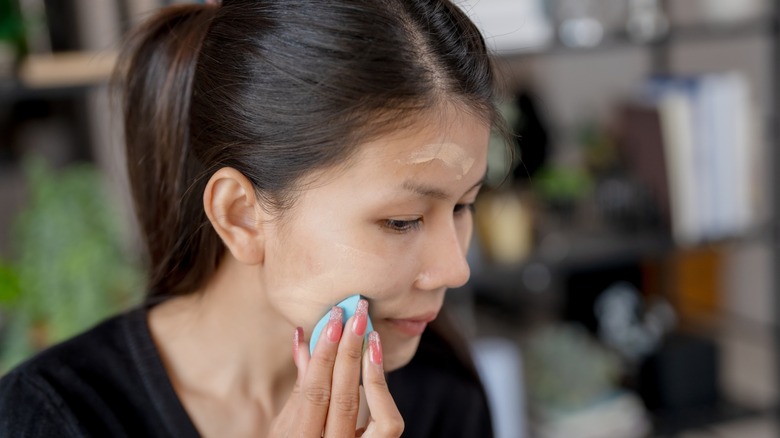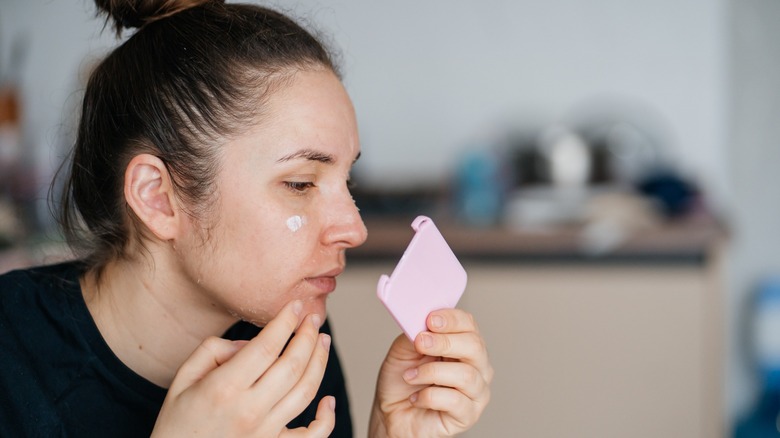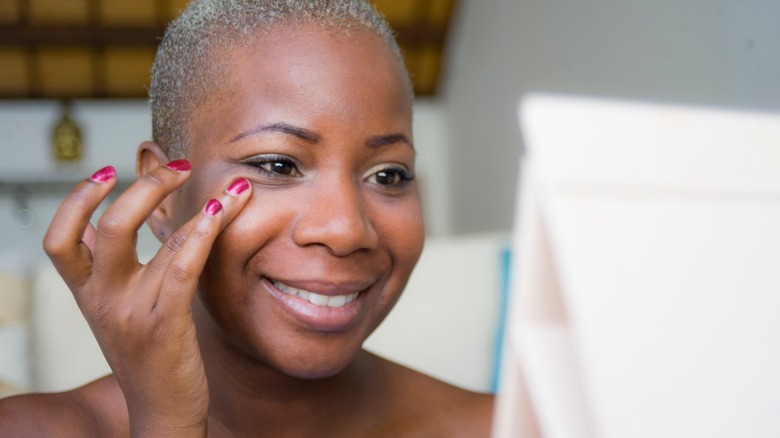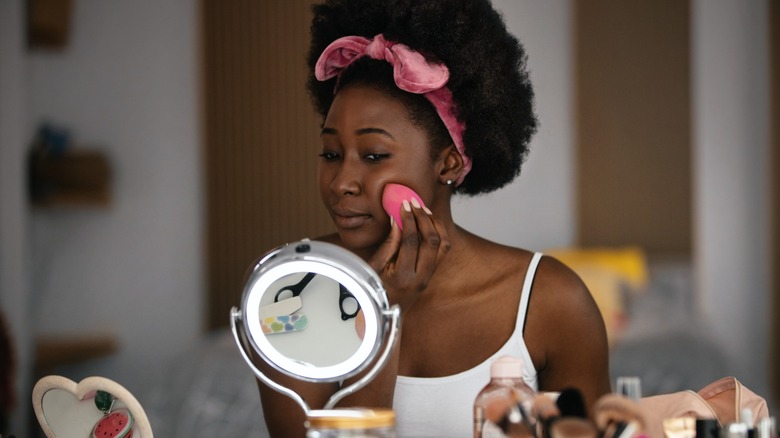Foundation Mistakes That Are Making You Look Older
We may receive a commission on purchases made from links.
If you find your makeup doesn't quite have the same illuminating, youthful look it used to, it might be time to change your foundation. Our skin is like a canvas, and if it's not looking its best, unfortunately, we're never going to get a glowing masterpiece — no matter how snatched the rest of our makeup looks.
That said, for many people — especially those over 50 — finding the right foundation can seem like a chore. It's tempting to think the quickest solution to managing mature skin is to do everything in your power to cover it up, but this approach might actually be counterintuitive. As Caroline Hernandez, celebrity makeup artist exclusively tells Women.com, one of the biggest traps many of us fall into is choosing thick, full-coverage products, even if we don't need them. Though these foundations can look great on camera, in real life, they don't usually give the dewy, fresh look we associate with youth. "[These foundations] often sink into expression lines, which can really age us and actually make us look older than our actual years," Hernandez says. "These formulas can flatten radiance, especially on mature or dry skin," she adds.
Using wrong foundation — or even applying the right foundation incorrectly — can add years to your face without you realizing it. If you've been experiencing this, try a lighter product, such as a dewy-finish foundation or tinted moisturizer that will give the skin a hydrated-looking glow. "I love Chantecaille Future Skin Foundation for its hydrating, gel‑cream texture. This formula contains 58% water ... plus aloe, arnica, green tea, chamomile, and rosemary, it delivers a fresh, dewy glow without oiliness," Hernandez tells Women.com. However, the other mistakes you may be making could relate more to application techniques than your foundation's consistency or finish.
Using foundation as concealer can create a cakey, overdone look
As easy as it may be to apply a thick layer of foundation all over the face to cover any imperfections, this technique can cause you to look cakey and overdone. Instead, Caroline Hernandez suggests trying a lighter product and application, followed by a concealer over the top — but only on the areas that need it. "Strategically placed coverage will look way more flattering than full coverage over the whole face," she exclusively tells Women.com. Hernandez also notes that it's important to be mindful that the areas that require coverage are likely to change as our skin matures. "As we age, our concern may no longer be acne or even spots, but perhaps redness here and there," she says.
For the most even and youthful-looking application, Hernandez suggests, "[Use] a clean brush or a clean, damp sponge [and] apply thin layers of foundation, or tinted moisturizer/BB Cream, at the center of the face and blend outward." But remember, "Only build coverage where it is needed."
If you prefer to keep things simple, Hernandez recommends Ilia Skin Rewind, a foundation and concealer in one. "It's infused with squalene and niacinamide, which can help smooth texture and keep skin plump. But, be mindful with application as it can build quickly in areas you don't want to have build up," she says.
Not prepping the skin first can make your foundation cling to try patches
It's no secret that older skin requires some extra t.l.c., which means that forgetting to prep it before applying makeup is a huge mistake.
Older skin has a reputation for drying out faster than younger skin, which can cause the skin to look cracked if it's not properly moisturized. Add foundation on top of that and you're likely to end up with fine lines that are unintentionally magnified. Luckily, this is something that can be managed with proper skincare. "The right moisturizer for your skin needs to sink in and prepares the skin for the makeup to glide on and not settle into dry areas," she shares. If you have dry skin, try these five must-have skincare ingredients.
But proper skincare prep doesn't begin and end with moisturizing. Skipping out on steps like exfoliating can cause makeup products to cling to the patches of skin, leading to flakiness. "Not exfoliating the skin often enough can cause dead skin cell build up and add to skin texture," Caroline Hernandez explains (and dry patches can are anything but youthful). "AHA formulas are partially good as they exfoliate rather than scrub the surface of the skin," she adds, suggesting a gentle exfoliation up to twice a week.
Skipping primer can leave your skin looking older
Uneven foundation application can ruin a good makeup look on anyone regardless of age, but on older skin, it's even more noticeable. You can easily combat this by making sure to follow up your skincare with a primer that is suitable for your skin type."Use a hydrating primer (one with hyaluronic acid) or a smoothing primer with light reflecting properties to add radiance, but not high shine," Caroline Hernandez exclusively tells us. This will help keep dryness at bay and provide a more youthful appearance.
Some foundations have specific primers they're designed to be used alongside (L'Oreal Paris Age Perfect Radiant Serum Foundation, for example, goes with L'Oreal Paris Age Perfect Face Blurring Primer). If your favorite product doesn't have a matching primer, Hernandez recommends Bobbi Brown Vitamin Enriched Face Base or Hourglass No. 28 Primer Serum. If you're still unsure which one to try, here's how to find the right makeup primer for your skin type. Just remember though, to avoid pilling or product breakdown, always use a water-based primer with a water-based foundation and a silicone-based primer with a silicone-based foundation.
Too much powder may result in a dry, matte foundation finish that's seriously aging
Though it's important to set most foundations with powder if you want it to last all day, too much finishing powder can be seriously aging on older skin. A heavy layer can dull and dry out your foundation (which will cause lines and texture to be more obvious). This makes it one of the most aging makeup mistakes. To avoid making this mistake, Hernandez recommends switching up your application. "Lightly powder with a clean brush, and keep the application of powder to an even minimum," she exclusively tells Women.com
But don't worry if you've already made a mistake and went a little heavy-handed with the pressed or loose powder, because there's a way to fix it. "If your makeup looks powdery, a light spray of a beauty elixir, water spray or hydrating fixing spray will help bring radiance back," Hernandez shares.
Applying foundation too quickly can leave you open to aging mistakes
We get it, we're all living busy lives, and it's rare to get more than 10 minutes to ourselves to do our makeup. But the more time you can set aside to apply your foundation, the less likely you are to make aging application mistakes. Hernandez recommends not rushing and applying foundation via your chosen method (whether that be a sponge or brush) slowly, paying close attention to what it looks like up close. "Check areas of concern with a magnifying mirror," she suggests during our exclusive chat, as this will allow you to take rectify any mistakes, such as dry or cakey patches or tide marks.
Equally, setting time aside to get things right means you can rectify it if your foundation settles in fine lines or wrinkles, as this can make us look years older. Hernandez suggests grabbing a Q-Tip to remove the excess. "Run this down the line in question and then gently pat around that area to seamlessly blend the color," she says. Follow these tips, and youthful looking foundation will be yours!
